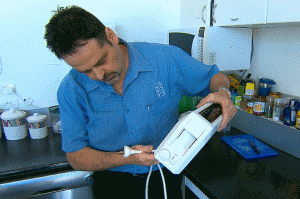
AS/NZS 3760:2022 states the following tests are to be completed
Visual Testing
Approximately 90% of faults are identified from visual inspection prior to the completion of the any electrical tests. A true visual inspection, conducted by a reputable service provider involves a comprehensive inspection of flexible supply cord, plug, appliance and socket. Covers and guards are checked to ensure they are attached, appliances are checked for rattles indicating the presence of small foreign objects that may interfere with the electrical safety of the appliance, and Class II appliances are checked for deep engraving which may impact on the insulation of the appliance.
Insulation Resistance
An Insulation Resistance test is required to check the integrity of the insulation that is protecting users from the live parts within the appliance. In the majority of cases, an Insulation Resistance Tester, or PAT (Portable Appliance Tester) is used to complete the insulation resistance test on an appliance.
Some items contain a soft switch which means that current must be applied to the item – effectively turning the item on or “powering it up”– on order for it to be tested. A Leakage Current Test should be completed on items with a soft switch.
Leakage Current Testing
This test involves “powering up” the appliance and measuring any current leakage. To conduct this test, the tester must be connected to the mains power so the use of a battery powered PAT to complete this test is impossible.
Polarity
A polarity test is conducted on leads with rewire able plug or socket to check the active and neutral wires are connected correctly. Whilst testing polarity using a Multimeter or Insulation Resistance Tester is slow and complex, a PAT completes this test quickly and efficiently whilst also testing for short circuits between conductors.
Earth Resistance
An earth resistance test will confirm whether the earth connection of the equipment, between the plug and exposed external metal parts, or the plug and the socket, is no greater than 1 ohm. One method of testing this is to conduct an earth continuity test but as that test does not take in to account any damage to the earth connection or conductor it is less effective than an earth bond test.
An earth bond test be conducted by a PAT applies a higher current to determine whether in the event of a fault, the equipment can handle that fault current correctly, and to measure earth resistance.
Get a free quote
"*" indicates required fields